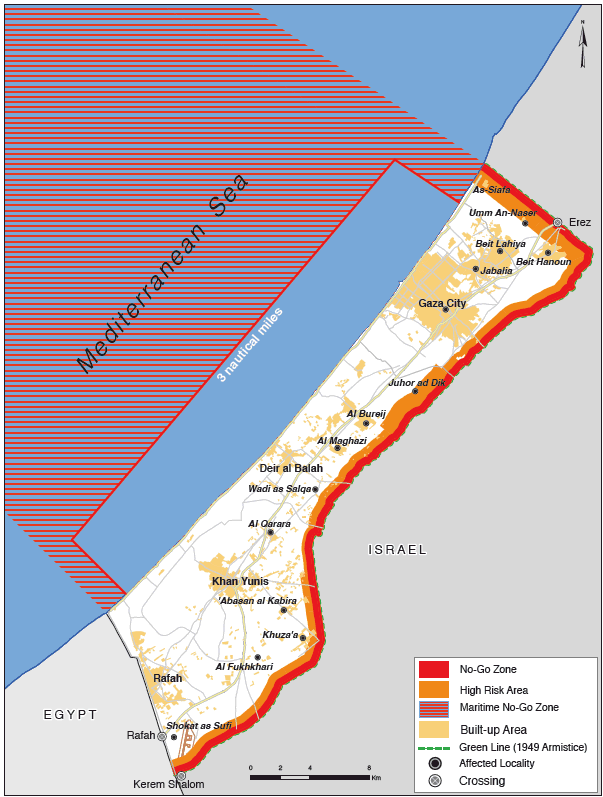Fast Facts
- The population of Gaza is 1.6 million, with over 50% under 18.
- 38% of Gazans live in poverty.
- 26% of the Gazan workforce, including 38% of youths, is unemployed.
- The average wage declined by over 20% in the past six years.
- 54% of Gazans are food insecure and over 75% are aid recipients.
- 35% of Gaza’s farmland and 85% of its fishing waters are totally or partially inaccessible due to Israeli military measures.
- 50-80 million litres of partially treated sewage are dumped in the sea each day.
- Over 90% of the water from the Gaza aquifer is undrinkable.
- 85% of schools in Gaza run on double shifts.
- About one-third of the items in the essential drug list are out of stock.
- Since the beginning of 2010, 64 Palestinian civilians have been killed and 621 injured by Israeli forces; over 60% of casualties occurred in the access-restricted areas. Another 60 civilians were killed and 137 were injured in tunnel-related accidents.
1. The Gaza blockade (through the land, air and sea) is a denial of basic human rights in contravention of international law and amounts to collective punishment. It severely restricts imports and exports, as well as the movement of people in and out of Gaza, and access to agricultural land and fishing waters. Gazans are unable to provide for their families and the quality of infrastructure and vital services has deteriorated.
2. Despite measures taken to ease the blockade in June 2010 the humanitarian situation has remained extremely fragile. While imports have increased, they are still at less than 40% of the pre-2007 levels. Exports remain tightly restricted and are limited to agricultural produce to Europe, and Gazan businesses cannot access their traditional markets in Israel and the West Bank. Access to land and sea remains highly restricted.
3. Only a minority of the projects aimed at improving housing and vital services in Gaza, submitted for approval by the international community, have been approved by the Israeli authorities. Implementation of approved projects is impeded by funding shortages affecting the operating agencies, as well as by the limited capacity at the single crossing for goods. The internal Palestinian divide is an additional factor undermining the quality of vital services.
4. Lack of respect for international humanitarian law has continued to result in civilian casualties, particularly during escalations in armed clashes and while enforcing access restrictions to border areas.
5. Thousands of people, many of them children, risk their lives smuggling goods through the tunnels under the border with Egypt every day. The thriving tunnel industry is a direct result of ongoing restrictions on the import of construction materials, the lack of employment opportunities, and the huge reconstruction needs in Gaza.
6. Gazans remain isolated and cut off from the rest of the occupied Palestinian territory. Entry into the West Bank, either via the Israeli Erez crossing or via Jordan, is prohibited for all Gazans. The volume of people allowed through the Egyptian Rafah Crossing remains limited, with hundreds denied passage each week.


